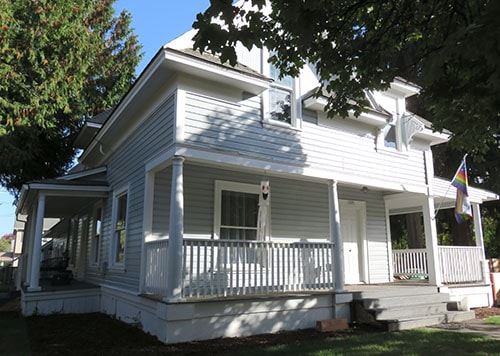503-992-1280 | info@fhfg.org |
1835 Elm Street

Newton & Eunice Walker house c.1891
The Newton and Eunice Walker House is a vernacular cottage with a blending of various architectural modes, combining stick style elements with Colonial Revival features and floor plan. The house was built on the former site of the town’s original Methodist Church, a very humble structure. The property was purchased by a realtor Loren Porter in 1890 from the church trustees for $1000. Porter seems to have had the cottage built to add to the lot’s value, as he lived elsewhere in town.
The house’s first inhabitants – Newton and Eunice Walker – came to Forest Grove in 1891 from Gaston and purchased the house from Porter for $2000 in June 1892. Born in 1830 in Illinois, Newton – supposedly a distant cousin of Lincoln - had served in a number of colonial wars in the West before migrating to Portland around 1850. He became involved in stock raising in Douglas County, and later settled in Washington County in 1876. In 1884, He married Eunice Brock, one of the earliest Oregon pioneers, and together they ran the Gaston Hotel and kept a 160-acre farm, before moving to the Grove. They lived in the house until selling it in 1898 to move to a house in Block 8, now known as Telvet Coffee.
The House soon found its way to the merchant John E. Bailey, who in 1908 sold the house for $2500 to his banking partner William B. Haines. William and his wife Laura lived in the house during a very stressful time for the family…A few years before, while working as cashier at his cousin Edward’s bank, it was discovered that $20,000 was missing from the books, and cousin Edward publicly blamed the shortage of funds on everyone except himself. All of this became publicly known in early 1908, when William was now President of the newly-formed Forest Grove National Bank (where US Bank corner building is/was). While living in the house, William Haines was also nominated to the position of Postmaster, but soon stepped down after charges of nepotism.
In 1913, the Haines couple sold the house to Royal and Lizzie Cole, who had arrived in the Grove a few years before. As passionate Congregational missionaries, the Coles travelled back and forth between the US and Armenia (Turkey), where they played an integral part in running the missionary schools in Armenia during the time from Ottoman rule to the Armenian genocides of the 19-teens. Their eight children (three of whom died young in Turkey) were all born in Armenia and were brought up to be missionaries, and the surviving five lived that life wholeheartedly. They seem to have learned the Armenian language and been very comfortable in that world. Most, if not all of the siblings went to Oberlin College, and when they arrived here, two of the sisters – Mary E. and Alice H. – taught at the high school. The third sister Nellie trained to be a kindergarten teacher, and when not teaching that and Sunday school, continued her missionary work abroad. After sister Mary passed away, the remaining sisters Alice and Nellie opened their “Cole Kindergarten” in the house, which they operated until 1956.
Many other interesting families have lived here since, with businesses operated out of the home. You may remember “Sew & Sew”, which was here for decades.
Research and Narrative by Skip Buhler.
